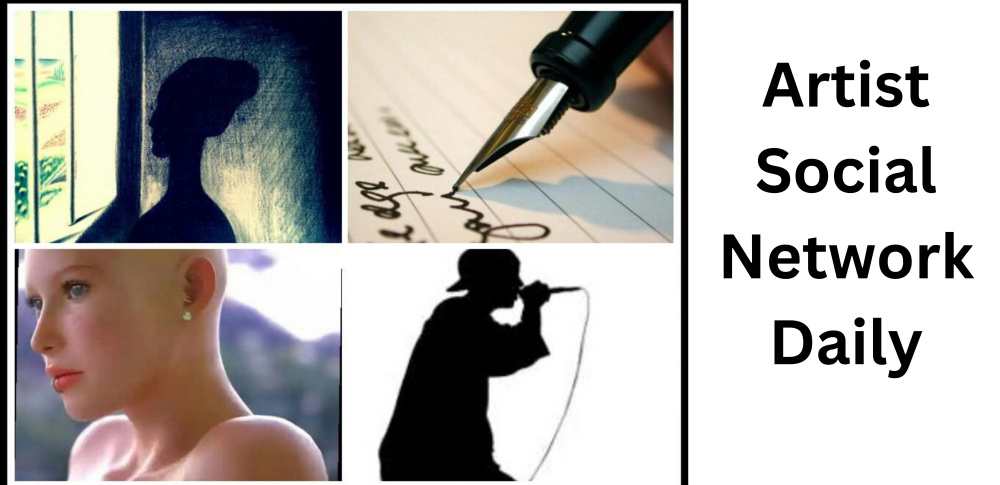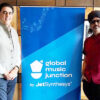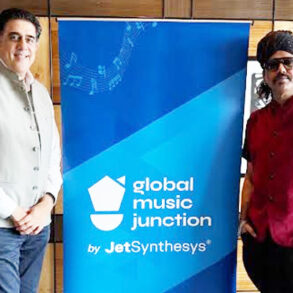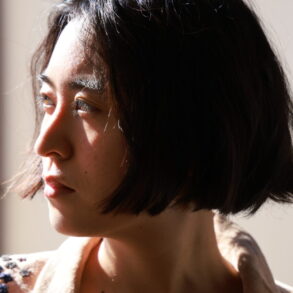We’re two-thirds of the way up the steep Burrawang track that runs behind Bundanon Art Museum and I’m already puffed.
I’ve joined a large group of artists, writers and members of the public who are here on Dharawal Country on the NSW South Coast for the opening weekend of Bundanon’s latest exhibition season, Thinking together: Exchanges with the natural world.
Bundanon invites visitors, just as its artists, to acknowledge and learn about the environment where the gallery sits. (Supplied: Jacquie Manning)
Thankfully, we’ve stopped momentarily to hear more from local First Nations custodians Joel Deaves and Jordan Thomas about the work they’re doing to care for this extraordinary part of the world.
Artists Keg de Souza and Robert Andrew are also on the walk, with the dazzling, expansive Bangli (Shoalhaven River) unfurling behind us.
The Bangli (Shoalhaven River) near the grounds of Bundanon Art Museum. (Supplied)
Isabel and Alfredo Aquilizan are back at the museum but all four artists have spent considerable periods of time here at Bundanon over the past year or so, undertaking residencies and bushwalks, spending time with local custodians and Bundanon’s natural resources team.
From their research and deep thinking with and about this landscape come their new commissioned works for Thinking Together.
And, just like this bushwalk, they’re surprising, rewarding and memorable, and likely to take your breath away.
‘Deep knowledge and deep time’
Hearing Deaves and Thomas talk about the more than a dozen different ecosystems that exist across the 1,000 hectares of bush that Bundanon encompasses, I can’t help but think of the exhibition — with the three living, moving, growing works of de Souza, Andrew and the Aquilizans — as its own kind of ecosystem.
Thinking Together is an exhibition that invites us to reconsider our often-overlooked or unseen connections with the natural world and what it can teach us about collaboration, reciprocity and the value of deep listening.
The Aquilizans’ use of repurposed cardboard boxes references the Filipino migrant tradition of the balikbayan, sending boxes of items home. (Supplied: Jacquie Manning)
These three major new commissions are shown alongside works by Greek-Australian visual artist Tina Stefanou, Thai-New Zealand artist Sorawit Songsataya and the Martu communities of central Western Australia, whose two large-scale collaborative paintings bookend the exhibition.
For Bundanon’s head of curatorial and learning, Sophie O’Brien, these Martu paintings are the foundational works of Thinking Together.
“They’re really the oldest and most continuous collaboration and communion with nature that is practical, sustainable and cultural. Deep knowledge and deep time is captured within them.”
As a series of thoughtful, joyful, contemplative encounters, de Souza, Andrew and the Aquilizans’ site-responsive works invite us to invest our own time and care and to reconsider what we can learn from the landscape at Bundanon, too.
One of the Martu paintings, Martumili Ngurra (This is all Martu’s Home), that bookends the exhibition, on display at Bundanon as part of Thinking Together. (Supplied: Zan Wimberley)
For O’Brien, it’s exactly these kinds of encounters that Arthur and Yvonne Boyd envisioned when they gifted this “place for making” to the nation in 1993.
“Most artists [at Bundanon] are in the process of making something and that energy brings its own direction. It’s what Arthur and Yvonne said we should be doing: making ways for audiences to engage with what artists do and the role of the artist. It’s not just to show the collection or to look at the landscape.
“I think it’s good … to be reminded of the importance of the artist, the role of the artist and the voice of the artist,” O’Brien says.
Invitation to collaborate with nature
Not every artist and exhibition at Bundanon engages as directly with the landscape as the artists in Thinking Together do, but for O’Brien and fellow curator Boe-Lin Bastian, it was a practical starting point for this exhibition, given the daily challenges of running an art museum, artist residency and live program in the bush.
“We’re having to collaborate with nature in a very straightforward way all the time, ourselves. So when there’s floods [or] there’s fires, [or when] there’s the bushwalks,” O’Brien says.
“The snakes are out at the moment.”
Bundanon is not just an Art Museum and artist residency. It’s also a wildlife sanctuary set on 1,000 hectares. (Supplied: MANA Creative)
O’Brien and Bastian were also motivated to create their latest exhibition after discussing the idea that new knowledge can only be generated if it’s done collaboratively.
They began to wonder how people could make new knowledge at Bundanon.
“The natural world would have to be our collaborator because that’s what we’re engaging with,” O’Brien says.
Artists were invited to respond to this broad provocation of collaborating with nature — but their points of departure from here are each wondrously different.
They’re also noisy and messy, and they have a mind of their own.
Marking time
One of the first things Robert Andrew did after arriving at Bundanon was head to the river and remove his shoes.
“It’s one of those places where, as soon as you put your feet in the water, you get very positive feedback from that interaction,” he says.
Andrew is an installation artist and Yawuru man who is known for his elegant, large-scale robotic works that use locally sourced materials from Country to etch and hammer and reveal language onto walls.
His latest work, ‘new eyes — old Country’, pushes this work in a new direction. “It’s taken me from a literal language back to an oral or recorded language in a sense. It’s a story.”
That story is the Shoalhaven River, or rather, Andrew’s experience of it.
Over several visits, he spent hours on the river with Bundanon’s cultural liaison manager, Jerome Comisari, and Uncle Noel ‘Nook’ Webster, recording footage with his hand-held camera and drones.
Set across the art museum’s impressive 25-metre wall, ‘new eyes — old Country’ presents this gorgeously meditative footage on a gently rotating screen attached to a robotic arm that moves up and down along the wall.
Attached to the screen is a collection of charcoal pieces gathered from local sites of cultural burning that, over 38 minutes, gently trace an abstracted outline of the river system. As the exhibition continues, the charcoal reiterates its path, slowly bringing the river into being on the wall.
Robert Andrew is known for his elegant, large-scale robotic artworks. (Supplied: Jacquie Manning)
For Andrew, these markings acknowledge ideas of time and the knowledge held within the river systems.
“Passing that first lot of cliffs in the boat, you saw old, old time there within the stratification and different sedimentary layers of rock. And each layer is saying something different about materiality and how long we’ve been here and how nature is always evolving,” Andrew says.
“There’s no way to display everything the river knows. The depth of what’s held within and what it’s provided for thousands of years is beyond my imagination.
“So this is just my personal exploration of that fact … All I want to do is plant the seed for a different way of seeing it.”
Homes among the gum trees
For the Filipino-born Isabel and Alfredo Aquilizan, it was an encounter with Arthur Boyd’s own work and his response to the landscape’s reflection on the river during their second site visit that got them thinking about trees, specifically.
“We thought, ‘Why don’t we create some kind of reflection?'” Alfredo says.
Reflection is a built-in part of the process for the husband and wife collaborators, who are known for their large-scale installations that use cardboard and community workshops to create works within works and playful spaces for slowing down and sharing stories.
Over several months, the Aquilizans and Bundanon’s learning team worked with members of the public to create drawings and cardboard sculptures that explore the tree as a site of habitation and home.
Some of the intricate detail in REFLECTIONS/HABITATIONS, made almost entirely from cardboard. (Supplied: Zan Wimberley)
As these workshops continue over the course of the exhibition, new pieces will continue to be added to their installation, REFLECTIONS/HABITATIONS.
This overwhelming sculpture, rich in idiosyncratic, tiny tableaux, takes the form of one half of a felled tree — from branches to roots — with the other half captured in reflection on the floor.
The toppled tree prompts questions about the impacts of deforestation, and the loss of land and habitats to the sprawl of new housing developments.
The idea of home has long recurred in the work of the Aquilizans, migrants who returned to the Philippines in 2024 after 18 years living in Australia.
With each new installation the Aquilizans make across the world, small pieces are taken from one work to help propagate the next, continuing the collaboration and extending the community around their work.
“The most rewarding thing for us is when people come in, they see the work, they add to the work and it changes. And it changes something in them,” Alfredo says.
If these mushrooms could talk
Interdisciplinary artist Keg de Souza’s introduction to Dharawal Country and Bundanon included a site tour with natural resources manager Michael Andrews.
Keg de Souza has taken the strange sounds of living mycelia and incorporated them into her artwork. (Supplied: @tadsouden)
When she wasn’t tagging along with Andrews, de Souza was learning more about mycelium, the fungal “neurological” network that shares knowledge between plant species and works to keep soils and trees healthy.
“I was thinking about the more-than-human and what we as humans can learn from these more-than-human connections and the ways that plants and trees communicate with each other,” de Souza says.
“The more I learnt about mycelium, the more I realised the parallels with so much of the way that I want to think about learning.”
Her work often centres historically and otherwise marginalised voices, a focus informed by her Goan ancestry and the more than 450 years of Goan culture lost to Portuguese colonisation, as well as her experiences living as a settler on unceded Gadigal land in Sydney.
Thinking Together is all about the connection between the human and the non-human. (Supplied: Jacquie Manning)
Drawing on these multiple references, Growth in the Shadows is, at first glance, an installation of two heavy, terrarium-like Wardian cases.
These 19th century colonial inventions were used to transport plant specimens across the globe and became a central tool for economic botany.
At Bundanon Art Museum, these custom-built cases house living mycelia threads, whose electronic pulses are fed through a specialised sound system to create a live, constantly changing soundtrack of electronic gurgles, strange clanking sounds and chatty static.
The soundscapes illustrate just how active the mycelium networks are, but scrawled across their glass is a series of mind maps that also track what de Souza has learnt from observing them.
They are sprawling, fascinating illustrations that offer provocative and poetic invitations for visitors to reflect on their own “networks”.
The noisy poetry of the mycelium felt to me like a gently urgent call for us to prioritise care and collaboration with each other, an invitation we should all consider.
Thinking together: Exchanges with the natural world is at Bundanon until June 8.
This post was originally published on this site be sure to check out more of their content





